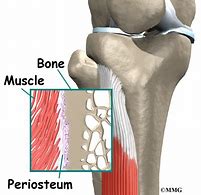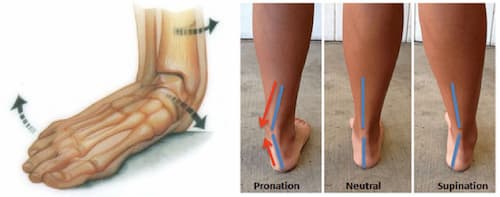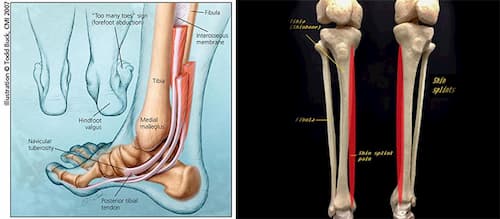ShinSplints

Do I Have Shin Splints?
Shin splints are pain along the tibia, the large bone of the lower leg or also called the shin bone. The pain is present during any type of activity when someone is on their feet for prolonged
Shin splints can be a sign of flat feet[/caption periods of time. Some people it starts within 5 minutes of exercise, others it comes on gradually as the exercise continues. Upon resting the pain goes away.
Children can also experience leg pain and the parent will find themselves having to rub their child’s legs at night so they can go to sleep. This pain is often dismissed by pediatricians as growing pains.
Other causes of shin pain that should be ruled out are stress fractures of the tibia, compartment syndrome, large muscle tears and blood clots. If the pain is along the tibia and comes and goes with exercise, the most common diagnosis is shin splints.
 What Are Shin Splints?
What Are Shin Splints?
Pain occurs along the tibia when muscle fibers of either the anterior tibial or posterior tibial tendon pull away from the periosteum of the tibia. This feels like an ache or burning pain along the shin bone and is very painful and can limit activity.
What Causes Shin Splints?
When small muscles pull along the tibia this causes the pain. Two major muscles - the anterior tibial tendon and the posterior tibial tendon- are the muscles that are involved. If pain is on the outside and front of the tibia it is due to the anterior tibial tendon. Pain along the inside and back of the leg are due to the posterior tibial tendon, which is the most common. Shin splints usually occur during or after exercising.
The anterior or posterior tibial tendon muscular fibers are attached along the tibia in the leg and run down and are attached into the foot via a tendon. Tendons attach muscles to bones. These muscular fibers pull away from the tibia when their tendinous attachment in the foot bones are being stretched. Shin splints generally don’t occur from a one time pulling on the muscular attachment into the tibia but more from a continual pull such as in various activities like running, jumping, walking or even skiing.
 The tendons in the foot will be stretched in cases where the foot rotates in -pronation or the foot rotates out- supination. When the foot pronates the ankle rolls in and the arch flattens putting a stretch on the posterior tibial tendon. With flat feet the forefoot also rotates causing an even larger pull on the posterior tibial tendon. As the tendon is being overstretched in the foot, the muscular attachment into the tibia pulls away from the tibia thus causing pain in the back and inside of the leg thus causing posterior shin splints.
The tendons in the foot will be stretched in cases where the foot rotates in -pronation or the foot rotates out- supination. When the foot pronates the ankle rolls in and the arch flattens putting a stretch on the posterior tibial tendon. With flat feet the forefoot also rotates causing an even larger pull on the posterior tibial tendon. As the tendon is being overstretched in the foot, the muscular attachment into the tibia pulls away from the tibia thus causing pain in the back and inside of the leg thus causing posterior shin splints.
During supination as in people with average to high arches or if someone who is pronating compensates and turns the foot out, the anterior tibial tendon is being stretched causing anterior shin splints. Sometimes both tendons are being stretched and the pain is in the front, back and side of the leg.
How do you treat shin splints?
Since shin splints pain is due to pronation or supination which occurs in the foot, the area that needs to be treated is the foot. Many trainers, doctors and physical therapists treat shin splints only by using shin splint taping or aggressively massaging the leg. This may provide a small amount of relief but is not the main treatment.
The best way to treat shin splints is with good supportive shoes and arch supports. If the arch supports are only a cushion, this will not solve any problems. The arch support has to be a true support in the arch and if the person has flat feet, there also needs to be support in the forefoot. J1 insoles are the only over the counter arch support on the market that not only truly supports the foot but supports the foot to the ball of the foot and not end mid-arch. J1 insoles has created an insole that corrects overpronation and oversupination, providing your foot with the corrective support it needs in all 3 areas. Insoles for flat feet seek to correct overpronation by placing the heel in neutral position, providing true support for the fallen arch and correction for the forefoot varus. J1 insoles are the best arch support for treating shin splints. View our full line of affordable, medical grade insoles for both adult and children here.

J1 insoles for average arches. The arch supports provide 3 point correction in the heel, arch and forefoot. If you have average/high arches and having pain, you can benefit from the extra support of j1 Insoles. Our line of specially designed insoles that gently hold your feet in the proper position for comfortabe walking, running or standing. Our customers love how j1 Insoles for average arches truly support the arch, they are the most supportive OTC support you will find.
j1 Insoles for flat feet are a patented 3-point design to provide a support system specifically for flat feet. When non weight bearing, if you look in the arch area, you will see an arch. However, when stading, if your arch flattens out and/or if you can make your ankles roll in then you have a flexible flat foot. Meaning you have an arch but the arch collapses or pronates when standing and thus your arch flattens out. j1 Insoles for flat feet are designed for people with flexible flat feet to bring your arch back up to neutral and also correct the foot in all 3 areas- heel, arch and forefoot. Many OTC supports will not have any arch support thus not correcting the flexible flat foot. Some supports will only correct in the arch and this will make it feel like a rolled up sock in the arch and that is why it is necessary to correct in all 3 areas of the foot.
Strengthening exercises for shin splints
Since pronation and supination are the causes of shin splints, the best exercises for shin splints are those that strengthen the anterior and posterior tibial tendons. It’s possible to improve the strength of your arch over time with various foot exercises. Implementing stretches that target the various tendons in your feet and ankles can also loosen tightness that leads to improper pronation. When someone has too much pronation and flat feet, it is best to combine stretching and strengthening exercises with j1 insoles. J1 insoles are the only patented over the counter arch support on the market for flat feet. J1 insoles patented 3 point design corrects the flat foot in all 3 areas - heel, arch and forefoot.
Targeting your leg muscles with strength building exercises can increase the support your feet and legs provide the rest of your body. This translates to less overpronation over time.
Helpful exercises include calf raises, squats, or lunges. All three target the large muscle groups located in your legs with the goal of providing more structural support. The sock gathering exercise where the toes curl a sock up that is laid on the floor can also help strengthen the arch.
Calf stretch: To relieve tight calves and tendons, place your hands on a wall. Make sure your feet are straight forward not pointing outward. Place one foot behind the other and bend your front knee toward the wall until you feel the back of your heel stretching. Hold the stretch for 15 seconds. Switch your feet and repeat 10 times each side 2-3 times per day.
Golf ball/tennis ball roll: Place a ball on the ground and position the arch of your foot over the ball. Roll your foot in a rotating or forward motion to loosen the fascia located on the bottom of your feet. For a firmer touch, use the golf ball.
J1 insoles relieves the pain associated with shin splints. The pain will go away permanently as long as you are wearing the insoles. If you continue to have pain while wearing j1 insoles, consult your doctor to rule out other problems such as compartment syndrome, fracture or blood clots. If you did get relief of pain and now the pain is returning, your shoes and/or insoles may need to be replaced.






